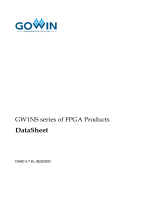
Figure 2-4 Subframe Format
1. Sync Preamble
There are X, Y and Z, which respectively indicate that the subframe is
the beginning of Channel 1, Channel 2, and Block.
2. Auxiliary
Currently, these four bits are used to store additional sample bits when
the audio data exceeds 20 bits. For example, when 24 bits of sample
data are to be transmitted, they are used to store the last four bits of
audio data.
3. Audio Sample Word
Store the actual sample data with a length of 20 bits and transmit it in
LSB priority mode. When the sample is less than 20 bits, the unused
LSB bits should be set to zero.
4. Validity Bit
This bit is used to identify whether the data in the subframe is correct. If
it sets to 0, it means that the data in the subframe is correct and can be
received; otherwise, if the bit is 1, it means that the receiving end
should ignore the subframe.
5. User Bit
This bit is user-defined bit. Each group of sample transmits one bit. 192
groups of sample are transmitted to form 192 bits of information, and
each channel has a group of 192 bits of user information.
6. Channel Status Bit
This bit is the same as the user bit, and each group of sample transmits
one bit. Finally, each channel has a group of 192 bits channel status
information. This 192 bits channel status information is divided into
professional and consumer, which is determined by the first bit. When it
is set to 1, it is in professional mode, and when it is set to 0, it is in
consumer mode.
7. Parity Bit
Parity Check is a simple error check method that uses Even Parity
Check to determine if an odd number of bits is wrong.
2.3.3 BMC Encoding
Biphase Mark Code, or BMC, belongs to a phase modulation encoding
method, which is used to mix clock signal and data signal for transmission.
Its principle is to use a double clock frequency of transmission bit rate
as a benchmark. An original data is split into two parts. When the data is 1,
shift the electrical level (0-1 - > 1-0) for one time in the clock cycle to make
the data into two data with different levels, to be10 or 01; When the data is
0, it does not need to shift levels, to be11 or 00. At the same time, the level
at the beginning of each bit should be different from the level at the end of
the previous bit, so that the receiver can determine the boundary of each
























